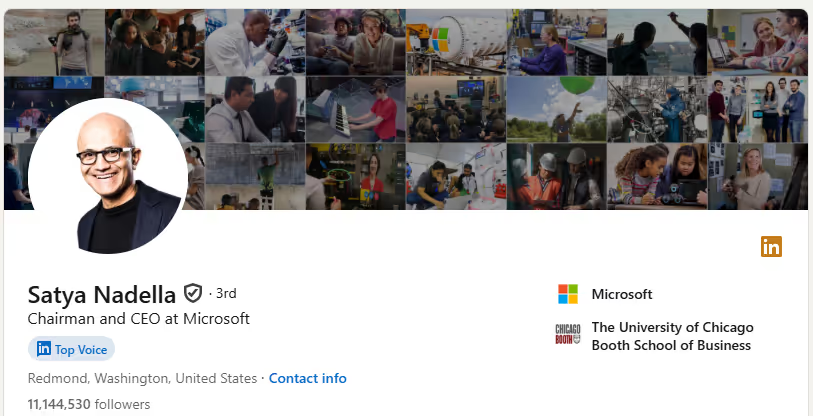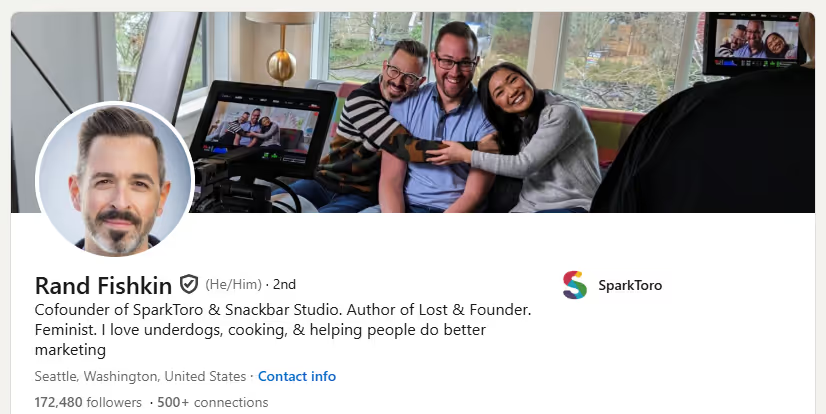Ready to create more pipeline?
Get a demo and discover why thousands of SDR and Sales teams trust LeadIQ to help them build pipeline confidently.



LinkedIn is the world’s largest social network for professionals, which means that maintaining a robust presence there is increasingly essential for business and career success.

Making the most out of LinkedIn’s potential is only possible by creating an engaging profile that captures your audience’s attention.

By studying examples of effective LinkedIn profile examples, you can incorporate the best elements into your profile and enjoy better business outcomes because of it.
Get a demo and discover why thousands of SDR and Sales teams trust LeadIQ to help them build pipeline confidently.
In today’s social network-driven world, LinkedIn serves as the go-to platform for sales professionals to connect with prospects, share insights, and build their personal and company brands.
With more than 1 billion users from over 200 countries and territories on the platform, a strong LinkedIn presence helps reps showcase their expertise and build credibility with a global audience.
By using LinkedIn strategically, you can attract more leads, strengthen relationships, and ultimately position yourself to close more deals and crush your targets. That’s why we thought we’d share top LinkedIn profile examples across various niches so you can learn best practices and optimize yours today!
Getting the best results from LinkedIn starts with creating an effective profile that captures the attention of other users.
While your LinkedIn profile should feel like an extension of your professional resume, it’s important to remember that it’s not all about you; it’s about your audience and what matters most to them.
A creative professional, for example, might be best off adding some more imaginative elements to their profile — like eye-catching imagery and clever copy. An executive at a large enterprise, on the other hand, should likely strive to convey professionalism and authority.
That said, LinkedIn is not MySpace, and it’s not Facebook either.
When crafting your profile, it’s important to remember that it’s not just about aesthetics. Simply put, your LinkedIn profile is a strategic tool you can use to propel your career forward by connecting with the precise audience you aim to reach.
What makes a strong LinkedIn profile varies depending on your role. If you’re in marketing at a SaaS startup, for example, you can use LinkedIn to engage in social selling by discussing topics relevant to your company’s niche.
If you’re in sales at the same company, your approach might be more direct, highlighting your value proposition and creating direct outreach opportunities.
To learn more about how to optimize your LinkedIn profile, check this out.
Maximizing the value of LinkedIn is only possible when you ensure your profile reflects your unique roles and objectives; this increases the chances it resonates with your target audience.
Whether you’re a creative designer showcasing a portfolio, a sales leader demonstrating your ability to close deals, or an executive highlighting your strategic vision, your profile should align with what matters most to your industry and network.Luckily, with over 1 billion users on LinkedIn, you don’t have to reinvent the wheel when you begin building out your profile.
With that in mind, let’s examine some good LinkedIn profile examples across a range of different job functions to give you a better idea of how some of today’s most effective professionals are using LinkedIn to soar to take their careers to the next level — and how you can use the platform to do the same.
Did you know that 98% of Fortune 500 CEOs who are on social media use LinkedIn? Phrased another way: LinkedIn is table stakes for members of the C-suite. Executives should use their LinkedIn profiles to establish thought leadership, build trust with stakeholders, and highlight their strategic visions.
Whether you’re a CEO driving company growth, a CMO shaping brand strategy, or a COO optimizing operations, your profile should reflect your expertise and leadership style.
For established enterprises, executives should focus on showcasing industry influence, highlighting major achievements, and connecting with key partners or investors.
Executives at earlier-stage companies, on the other hand, might lean more into storytelling, sharing the company’s mission, vision, and trajectory. Satya Nadella, chairman and CEO of Microsoft

Holding the reins of a company worth more than $3 trillion makes you pretty popular, as demonstrated by Microsoft CEO and Chairman Satya Nadella’s 11-plus million LinkedIn followers. Not surprisingly, Nadella’s LinkedIn profile serves as a template that all business executives can follow to unlock the full promise of the social network.
In addition to a highly intriguing cover photo and professional headshot that seems welcoming and invites you to say hello, Nadella’s “About” summary packs quite the punch: As chairman and CEO of Microsoft, I define my mission and that of my company as empowering every person and every organization on the planet to achieve more. Nadella’s also quite active on LinkedIn, publishing a steady stream of thought leadership content that highlights cutting-edge technology and what’s possible with Microsoft’s solutions.
Startup leaders need LinkedIn profiles that tell a compelling story about their company’s mission and their role in driving innovation.
Whether you’re a founder seeking funding or a product leader building credibility, your profile should be dynamic and engaging. To make that happen, highlight achievements like funding milestones, product launches, and team growth, sharing insights that resonate with investors, customers, and prospective hires.
Above all else, remember that authenticity is key. Startup profiles should emphasize the passion and grit it takes to succeed in a fast-paced, hypercompetitive environment. Rand Fishkin, cofounder of SparkToro and Snackbar Studio

Rand Fishkin’s LinkedIn profile has it all: a professional headshot, a cover photo that showcases the startup leader’s personality and fun brand, a headline that gives you a bird’s-eye view of what Fishkin’s all about, and a brief “About” section that provides a rundown on what he’s accomplished to date.
Beyond that, what makes Fishkin’s profile so effective is that he publishes helpful thought leadership content on LinkedIn regularly. If you’re a marketer looking to learn more about your audience, you’d be wise to keep tabs on what Fishkin’s up to.
At a high level, sales reps should use LinkedIn to build credibility, nurture relationships, and ultimately encourage conversations with prospects. A strong profile should demonstrate expertise in solving customer challenges while highlighting personal sales success accomplishments, industry knowledge, and any awards you might have racked up.
At the same time, sales reps should also make it a habit to post customer success stories and share insights into products, services, and industry trends — transforming the profile into a valuable resource for prospects.
When it boils down to it, LinkedIn is a modern sales tool. As such, maintaining a polished, approachable profile can open doors to new opportunities.LinkedIn profile examples: Marketing teamFor marketers, LinkedIn is a place for publicizing creativity, expertise, and results. If you’re a marketer, your profile should reflect your ability to understand audiences, drive campaigns, and create compelling narratives.
Whether you’re sharing successful campaign metrics, insights into marketing strategies, or thought leadership pieces, you can position yourself as an industry expert — becoming a go-to resource within your field.
If you’re in customer success, focus on highlighting your ability to build relationships, drive customer retention, and otherwise create value for clients. A customer success professional’s LinkedIn profile should include success stories, metrics related to retention or upsell rates, and endorsements that call attention to your collaborative nature and sweet set of problem-solving skills.
By sharing insights about customer satisfaction, case studies, and ways to overcome challenges, you can establish your credibility, delivering more value to folks in your network. Your profile should position you as a trusted partner to clients — demonstrating your dedication to helping customers succeed.
According to LinkedIn data, more than 9,000 professionals apply for jobs on the platform every single minute. If you’re planning to do the same, it’s important to make sure your profile is optimized before firing off your next application.
Jobseekers should create LinkedIn profiles that promote skills and achievements, demonstrating the value they bring to would-be employers. Focus on clarity and specificity — including measurable results, awards, and endorsements that support your expertise.While you’re at it, customize your headline to reflect your career goals and what you’re trying to accomplish; use the “About” section to tell a compelling career story.
Since LinkedIn is a social network, networking is key. Engage with content relevant to your desired role or industry to show recruiters that you’re keeping pace with the evolution of your niche.
By fine-tuning your profile, you can significantly improve your chances of landing your next opportunity on LinkedIn.
While we didn’t include LinkedIn profile examples for every role — do engineers or people on the product team actually use LinkedIn outside of the times their bosses ask them to? 😉 — these examples should get you thinking in the right direction as you begin upleveling your profile.
Looking at successful LinkedIn profiles is like having a cheat sheet you can use to build your own without having to worry about getting in any trouble.
Instead of starting from scratch, use these examples to see what works — and what resonates with others in your field. Whether it’s a standout headline, an engaging “About” section, or just a unique way someone showcases their accomplishments, borrowing inspiration from other users can save you a tone of time while making it easier to improve your profile.As you get started with the process, here are three actionable tips to keep in mind:
By learning from other established LinkedIn users, you can quickly build a profile that stands out — and one that helps you achieve your business and career goals faster. What’s not to like? To learn more about what you can do to unlock the full potential of LinkedIn, here are some additional resources you might want to check out:
Try LeadIQ for free today and see how LeadIQ helps you send the right message to the right person at the right time.